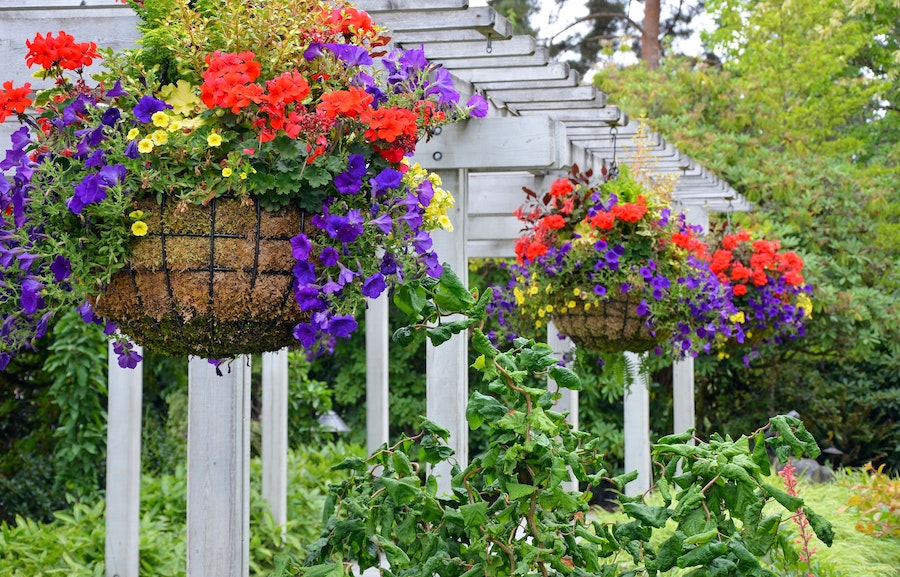Hanging basket masterclass: Here’s how to make the best flower display in easy 8 steps
So often my hanging baskets end up looking lacklustre and forlorn, with gaps where filler plants should have gone, holes in my moss liners and a lack of regular watering.
However, expert Nathan Syrett, assistant plant manager at Squire’s Garden Centres, has been running hanging basket masterclasses at its Stanmore store for a number of years, and offers the following advice to hanging basket hopefuls (including me)…
1. Choose the right materials and plants

Choose the right plants and materials for the job
Go for the biggest basket you can, as this will hold more compost and require slightly less watering than smaller baskets. Metal-framed baskets are ideal, but you will have to line them.
Various water-retaining liners include coir and sphagnum moss, although you can even cut up an old woolly jumper to line a basket, which will soak up the water and keep in the compost.

Place strands of moss across the metal frame to stop it slipping through the holes
If using moss (which you can buy at garden centres), use long strands of it laid laterally across the inside of the basket, working from the bottom, so the moss does not escape out of the holes.
Build the lining up in circles until it reaches the top of the basket, and lift it up to make sure you can’t see any gaps.
2. Make a reservoir

Make a reservoir from a circle of recycled plastic bag
Cut a small circle of plastic from your compost bag to make a reservoir in the bottom of your liner, to hold just enough water to keep the compost moist, while still allowing free drainage at the sides.
3. Add your compost

Use multipurpose compost
Multipurpose compost, preferably the sort which has added plant food, is ideal, although you will still have to feed your basket plants during the summer, bearing in mind how many of the nutrients will be washed away when you’re constantly watering. When you reach the top of the basket, firm the compost down so there are no air holes.
4. Choose your plants
If you want your basket to be admired from all sides, choose one larger plant to put in the centre, such as an upright fuchsia or geranium, and select around five other plants to place around it.
These could range from trailing petunias and calibrachoa, to bacopa, lobelia, nemesia, diascia and helichrysum, although there are many other suitable plants available.
5. Position the tall and the small

Use your plant pot as a template for the planting hole
Try positioning your chosen plants on top of the compost before planting, so you can decide which looks best where. Make sure your gaps are even when placing the outer plants.
Usually the tallest plant will go in the centre, surrounded by the lower trailers, which need to be planted closer to the edge, but if your basket is going to face in a particular direction, put the biggest plant at the back and the lower trailers in front of it.
To minimise any damage when planting, remove each plant from its pot and use the pot alone as the planting template, easing it down into the planting hole to make it the right size. Then your plant will slot right in.
View this post on InstagramHandy tip – use the flowerpot to make sure planting hole is the right size. #gardeningtips
Cover it with the compost you removed to make space for the hole. Repeat using the plant pot template until all your plants are in.
6. Hang it up
Hang up your basket on a wall bracket or other hook or frame (some hanging baskets are really heavy, so make sure your bracket is secured tightly and is strong enough to take the weight).
7. Be waterwise

Give it a good soaking
Water your basket well using a watering can rose. That way, the water will seep into the compost to reach your plants, rather than running straight through it.
8. Keep it healthy
Keep your basket well watered. In the height of summer you’ll need to do it twice a day, once in the morning and once in the evening. Feed your basket bedding plants regularly with either plant food or tomato food, following the instructions on the packet, and deadhead often to encourage further blooms.
The Press Association
Latest posts by The Press Association (see all)
- 5 new books to read this week - November 23, 2024
- 3 easy Mary Berry recipes to make this season - November 22, 2024
- In Pictures: Party stalwart kept New Labour in touch with traditional supporters - November 21, 2024
- 6 easy indoor exercises to try this winter – and why they are good for you - November 19, 2024
- Martin Clunes: I can’t afford to retire – I’ve got too many horses - November 19, 2024





















